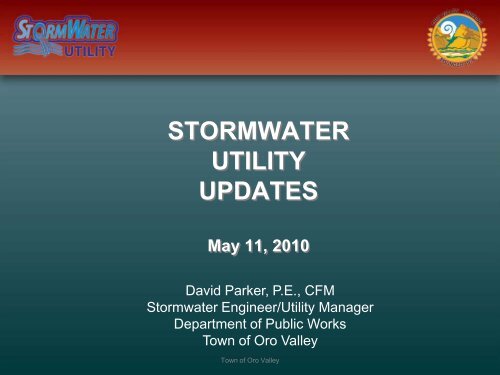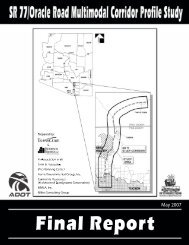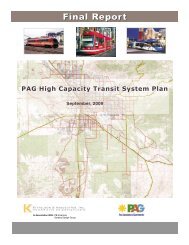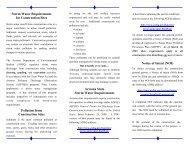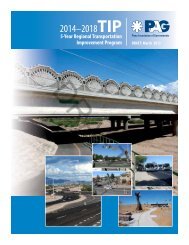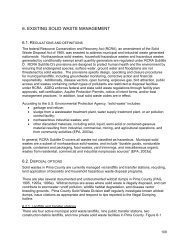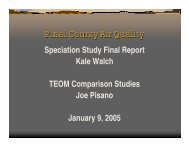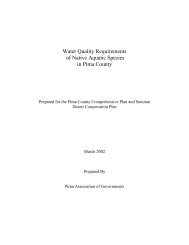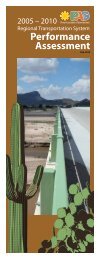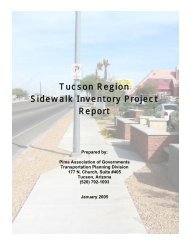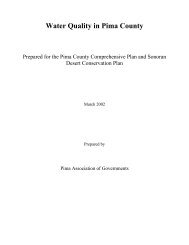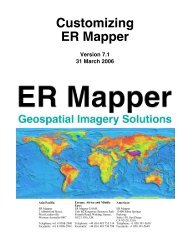Oro Valley Stormwater Ordinance
Oro Valley Stormwater Ordinance
Oro Valley Stormwater Ordinance
Create successful ePaper yourself
Turn your PDF publications into a flip-book with our unique Google optimized e-Paper software.
STORMWATER<br />
UTILITY<br />
UPDATES<br />
May 11, 2010<br />
David Parker, P.E., CFM<br />
<strong>Stormwater</strong> Engineer/Utility Manager<br />
Department of Public Works<br />
Town of <strong>Oro</strong> <strong>Valley</strong><br />
Town of <strong>Oro</strong> <strong>Valley</strong>
CONGRATULATIONS<br />
PAG SW WORKING GROUP<br />
FIRST PLACE IN THE NAFSMA 2009<br />
EXCELLENCE IN COMMUNICATION AWARD<br />
Town of <strong>Oro</strong> <strong>Valley</strong>
OUTLINE<br />
Organization Structure<br />
Rainwater Harvesting<br />
Drainage Criteria Manual Update<br />
SWPPP Program<br />
Town of <strong>Oro</strong> <strong>Valley</strong>
Town of <strong>Oro</strong> <strong>Valley</strong>
Town of <strong>Oro</strong> <strong>Valley</strong>
<strong>Stormwater</strong> Utility<br />
Structure<br />
<strong>Stormwater</strong> Utility<br />
– David Parker, Utility Manager, 229-5059<br />
• Utility Administration<br />
• <strong>Stormwater</strong> Management, AZPDES<br />
• CIP Program<br />
• Regulatory Liaison<br />
– Fernando Laos, Civil Engineer, 229-4818<br />
• Floodplain Management<br />
• New Construction Reviews<br />
• Minor Designs/H&H studies<br />
– Robert Wilson, Civil Tech, 229-4879<br />
• Field Inspections<br />
• Vector Control<br />
• Blue Staking<br />
• Minor Maintenance and Repair Projects<br />
Town of <strong>Oro</strong> <strong>Valley</strong>
Rainwater<br />
Harvesting<br />
Town of <strong>Oro</strong> <strong>Valley</strong>
Rainwater<br />
Harvesting<br />
Addressed in<br />
– Drainage Criteria Manual<br />
– Landscape <strong>Ordinance</strong> of Zoning Code (beginning June 1 st )<br />
Goal<br />
– Conserve Water while protecting downstream ecology<br />
Criteria<br />
– Use Passive or Active Systems (passive mandatory)<br />
– WH = Area impervious X 3,000 gal/acre<br />
• Based upon not taking more than 10% of pre developed flows plus<br />
delta<br />
• Assumes 60% of pre developed is runoff.<br />
All new Houses must be plumbed for potential grey<br />
water reuse<br />
Town of <strong>Oro</strong> <strong>Valley</strong>
Rainwater Harvesting<br />
Criteria Justification<br />
Hydrologic Analysis of Above Theory<br />
The above methodology has been analyzed technically against Rational Equation Calculation of pre vs. post discharge flow volumes. Both the two (2) and ten (10) year events are<br />
calculated below to corroborate that the harvesting of 3000 gal/storm/acre is less than the standard statistical rain events analyzed for detention requirements.<br />
1. Volume Produced for the two (2) year, 1 hour rainfall event:<br />
Q = CiA where:<br />
Qe = site discharge prior to development – Pre condition<br />
Qp = site discharge of developed impervious surface<br />
Qwh = available discharge that can be retained for water harvesting<br />
A = 1ac (assumed acreage for this example for both Pre & Post)<br />
Tc = 5min (assumed discharge time of concentration for both Pre and Post conditions)<br />
i = 5in/hr (TOV IDF 2 year rainfall intensity)<br />
Ce = 0.15 (calculated below using TOV/ADOT method and set as an average of NRCS soil types B and mixed b 50% & C 50% )<br />
Use P2,1hr = 1.2” (rainfall depth for TOV 2 year event)<br />
Ce,B soil = 0.12<br />
Ce,B50/C50 = 0.50(0.12) + 0.50(0.23) = 0.18<br />
Ce = 0.50(0.12) + 0.50(0.18) = 0.15<br />
Cp = 0.91 (for rainfall event depth of 1.2” and total development of impervious surface – Buildings, hardscape and paving)<br />
Qe = CeiA = 0.15(5in/hr)(1ac) = 0.75cfs<br />
Qp = CpiA = 0.91(5in/hr)(1ac) = 4.55cfs<br />
Qwh = Qp - Qe = 4.55cfs – 0.75cfs = 3.80cfs<br />
Volume retained from PCHydro V5.3.1 model analysis = 0.0793af = 25840gal<br />
2. Volume produced for the ten (10) year, 1 hour rainfall event:<br />
Q = CiA where:<br />
Qe = site discharge prior to development – Pre condition<br />
Qp = site discharge of developed impervious surface<br />
Qwh = available discharge that can be retained for water harvesting<br />
A = 1ac (assumed acreage for this example for both Pre & Post)<br />
Tc = 5min (assumed discharge time of concentration for both Pre and Post conditions)<br />
i = 7in/hr (TOV IDF 10 year rainfall intensity)<br />
Ce = 0.38 (calculated below using TOV/ADOT method and set as an average of NRCS soil types B and mixed b 50% & C 50% )<br />
P10,1hr = 0.496(P2,1hr) + 0.449(P100,1hr)<br />
P10,1hr = 0.496(1.19”) + 0.449(2.69”) = 1.79” – use 1.8”<br />
Ce,B soil = 0.34<br />
Ce,B50/C50 = 0.50(0.34) + 0.50(0.47) = 0.41<br />
Ce = 0.50(0.34) + 0.50(0.41) = 0.38<br />
Cp = 0.94 (for rainfall event depth of 1.8” and total development of impervious surface – Buildings, hardscape and paving)<br />
The difference between the Cp and the Ce is the basis of logic in the theory presented above. Essentially 0.94 – 0.38 = 0.56, or rounded off as 40% of the flow remains on site while<br />
60% runs off. This is important factor in maintaining the hydrologic balance of the desert.<br />
Qe = CeiA = 0.38(7in/hr)(1ac) = 2.66cfs<br />
Qp = CpiA = 0.94(7in/hr)(1ac) = 6.58cfs<br />
Town of <strong>Oro</strong> <strong>Valley</strong><br />
Qwh = Qp - Qe = 6.58cfs – 2.66cfs = 3.92cfs<br />
Volume retained from PCHydro V5.3.1 model analysis = 0.0957af = 31184 gal
Drainage Criteria<br />
Manual Update<br />
Revised Manual approved Feb 2010<br />
Major Revisions include:<br />
– Hydrologic Calculations<br />
– First Flush Requirements<br />
– Water Harvesting Requirements<br />
– Riparian Channel Design<br />
– All Weather/Dip Crossings<br />
– Detention Basins<br />
– SWPPP requirements for ALL Construction Projects<br />
Town of <strong>Oro</strong> <strong>Valley</strong>
CGP Highlights<br />
New OV SWPPP template being<br />
coordinated<br />
Utility approves and inspects all<br />
SWPPPs in Town<br />
Monthly Inspections by Town<br />
Notification of Final Stablization 2 weeks<br />
prior to ADEQ NOT submittal<br />
Town of <strong>Oro</strong> <strong>Valley</strong>
CGP Challenges<br />
Working with contractor to ensure<br />
adequate level of BMPs are used<br />
BMP Maintenance<br />
– Especially when developed is delayed<br />
Final Stabilization when using<br />
vegetation/hydroseeding on slopes<br />
Town of <strong>Oro</strong> <strong>Valley</strong>
CGP Challenges<br />
Town of <strong>Oro</strong> <strong>Valley</strong>
CGP Challenges<br />
Town of <strong>Oro</strong> <strong>Valley</strong>
CGP Challenges<br />
Town of <strong>Oro</strong> <strong>Valley</strong>
CGP Challenges<br />
Town of <strong>Oro</strong> <strong>Valley</strong>
CGP Challenges<br />
Town of <strong>Oro</strong> <strong>Valley</strong>
CGP Challenges<br />
Town of <strong>Oro</strong> <strong>Valley</strong>
CGP Challenges<br />
Town of <strong>Oro</strong> <strong>Valley</strong>
SWPPP Conclusion<br />
Program works very well through<br />
construction start<br />
Area that need emphasis are<br />
maintenance and final stablization<br />
Town of <strong>Oro</strong> <strong>Valley</strong>
QUESTIONS?<br />
Town of <strong>Oro</strong> <strong>Valley</strong>


